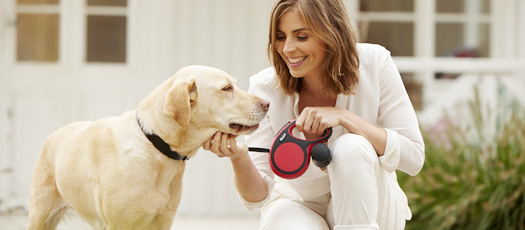
When your canine companion bites the leash
It’s an issue many dog owners face daily – you’ve barely started out with your dog before it starts to bite the leash. It’s fairly annoying, for one thing, and for another, it isn’t good for the leash in the long run, either. But there’s no need for this to be such an issue. All it takes to get it under control is some persistence and understanding.
Why does a dog bite the leash?
The first step in tackling this issue is knowing why a dog bites the leash in the first place. This is primarily the result of excessive high spirits, and because playing with the leash is fun. Because of its physical properties and the fact that it is held fast at one end, a leash is excellent for chewing and pulling from a dog’s perspective. If your dog seems more interested in carrying the leash, then it is because it likes to carry something in its mouth. So your furry friend bites the leash because it gets something out of it. That’s a key point.
In some cases, this behavior can be a displacement activity, such as when you are doing training exercises with the dog, alone or at obedience school, and something gets to be too much, too long, or too difficult for it.
The role of the human
As with many things that take place between humans and their canine companions, the dog owner is involved in this problem, too. As you already know, a dog is especially drawn to doing things that give it some kind of reward or return. Whether or not that is the case with leash biting is up to you. It doesn’t matter whether your furry friend started it on its own or someone from the family, like the kids, might have been the first to prompt it. From now on, the key point is to make sure the dog no longer succeeds with it with anyone and to take the fun out of it.
Helpful hints
There are various options to help your dog get out of the habit of biting the leash. Do what works best for you, including depending on the situation, and what is most effective with your dog. It’s important to be consistent. If your dog is sometimes permitted to bite the leash and sometimes not, all of your efforts will come to nothing.
Ignoring it
Sometimes all it takes is to stop and stand still right away with no comment and to ignore the dog (don’t even look at it) as soon as it starts (!) to bite the leash. If you don’t let yourself be drawn into the game, the dog won’t find it fun. Don’t start walking again until it has stopped. As soon as it starts doing it again, repeat this tactic.
If just standing still isn’t enough, you can also drop the leash. If your dog stays with you as a general principle, you can simply walk on without paying any attention to the dog. After a few steps, pick the leash back up while continuing to ignore the dog.
Alternatively, you can drop the leash and step on it. Stand still until your furry friend starts acting “normally” again.
Another possibility is to hang the loop of the leash over a fencepost while you are walking and the dog is biting it and walk on alone. If the dog stops, you can turn around and continue your walk with it. Don’t talk to it.
This will teach the dog that it isn’t much fun when it starts to bite the leash, but that you will keep walking with it if it stops.
Signal to stop
If your dog already knows a signal to stop, then say it as soon as it starts fiddling with the leash. When it stops, give it brief praise and walk on.
Aids
There are also two “technical” possibilities. First, you can put something whose taste the dog doesn’t like on the leash in the area where the dog plays with it. It might be lemon juice, or a couple of sprays of perfume or something similar. Or you can try using a chain leash for a time. Dogs don’t generally like to bite metal.
If your furry friend likes to carry something, then give it its favorite ball or something like it to carry while walking.
Stop practicing
If your dog bites the leash as a displacement activity, you should change the current situation. If you are training, for example, that would mean finishing up the training unit with just a couple more easy exercises.
Counterproductive responses
Even if you are annoyed by your canine companion’s behavior, be sure to avoid nervousness, “fits of rage” and so on. Any lack of calm, yelling, and so on will only exacerbate the problem, as the stress will rub off on the dog, and both of you will only get more and more worked up.
You should also be sure not to pull on the leash yourself. After all, that’s what your dog wants – to play tug-of-war with the leash.
So keep your cool at all times. If you do, you’re sure to succeed!


